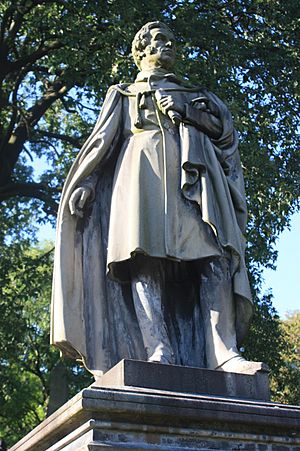Patrick Brewster facts for kids
Patrick Brewster (born 20 December 1788 – died 26 March 1859) was an important Scottish church leader. He spent most of his life working in Paisley, Scotland.
Patrick Brewster's Early Life and Career
Patrick Brewster was born on 20 December 1788. He was the youngest of four sons. His older brother was the famous scientist Sir David Brewster. Their father wanted all his sons to become ministers in the Scottish church. So, Patrick studied theology, which is the study of religious beliefs.
On 26 March 1817, he became a "probationer." This meant he was ready to become a minister. In August of that year, he was chosen to work at the Abbey Church of Paisley. He officially became a minister there on 10 April 1818. He served the church for almost 41 years. He passed away at his home near Paisley on 26 March 1859.
A Leader for the People
Patrick Brewster was very popular with working-class people. Many people attended his public funeral on 4 April 1859. A few years later, in 1863, people raised money to build a monument to remember him. This monument is in Paisley cemetery. The statue on top was made by John Mossman. It stands in a special spot, right near the entrance, where many people can see it.
Patrick Brewster's Beliefs and Work
Patrick Brewster was a very well-known speaker in his local area. He had strong political ideas. He was a "moral-force Chartist." This means he supported the Chartist movement, which wanted more rights for working people in Britain. He believed in peaceful ways to make changes.
He often spoke out about important public issues. He believed in:
- Ending the slave trade (making slavery illegal).
- Stopping the "Corn Laws" (rules that made bread expensive).
- Promoting temperance (reducing or stopping alcohol use).
- Creating a national system for education.
Brewster wrote several sermons and articles. One famous collection of his sermons was called The Seven Chartist and Military Discourses. He also wrote about the rights of poor people in Scotland. He contributed to the Edinburgh Cyclopædia, which was a large encyclopedia. He even wrote about a fossil tree found in a quarry for the Transactions of the Royal Society of Edinburgh.
Unlike his brothers, Patrick Brewster did not leave the Church of Scotland during the "Disruption of 1843." This was a time when many ministers left to form a new church. He chose to stay with the established church.


